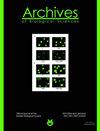Apifloristic diversity in the eastern Mediterranean region: Implications for biodiversity conservation and use
IF 0.8
4区 生物学
Q4 BIOLOGY
引用次数: 0
Abstract
The ecological role of honeybees in the world and their value for sustainable agriculture and food industry are more important than ever. For this reason, we study the apiflora in the eastern Mediterranean region of T?rkiye in the context of planning bee forests aimed at biodiversity conservation. The results show that honeybee forests are quite rich in both endemism and apifloristic diversity. A total of 511 plant taxa belonging to 264 genera and 59 families were identified, of which 335 (65%) taxa were evaluated as nectar (N) and/or pollen (P) bearing honey plants (45 N, 54 P, and 236 N&P). In terms of apiflora, the richest families are Fabaceae (n=76, 3 N, 73 N&P), Lamiaceae (n=57, 19 N, 38 N&P) and Asteraceae (n=44, 1 N, 10 P, 33 N&P). Nectariferous plants were more common at higher elevations, while polleniferous plants were more common at lower elevations. According to the Shannon-Wiener diversity index, the highest diversity values were found in honeybee forests at higher elevations and the lowest diversity values at lower elevations. Sorensen analysis also showed that floristic similarities among honeybee forests ranged from 1% to 42%. Cluster analysis supported these differences by dividing the forests into two separate groups.东地中海地区蜜蜂区系多样性:对生物多样性保护和利用的启示
蜜蜂在世界上的生态作用及其对可持续农业和食品工业的价值比以往任何时候都更加重要。为此,我们研究了东地中海地区的植物区系。Rkiye在规划蜜蜂森林的背景下,旨在保护生物多样性。结果表明,该地区蜂林具有丰富的特有蜜蜂种类和蜜蜂区系多样性。共鉴定出59科264属511个植物分类群,其中335个(65%)分类群为含蜜(N)和/或花粉(P)的蜜植物(45个N, 54个P和236个N&P)。在植物区系方面,最丰富的科是豆科(n=76、3 n、73 n &P)、Lamiaceae (n=57、19 n、38 n &P)和Asteraceae (n=44、1 n、10 P、33 n &P)。蜜系植物在高海拔地区多见,而授粉植物在低海拔地区多见。Shannon-Wiener多样性指数表明,高海拔的蜂林多样性值最高,低海拔的蜂林多样性值最低。Sorensen分析还表明,蜜蜂森林的植物区系相似性在1%到42%之间。聚类分析通过将森林分成两个独立的组来支持这些差异。
本文章由计算机程序翻译,如有差异,请以英文原文为准。
求助全文
约1分钟内获得全文
求助全文
来源期刊
CiteScore
1.40
自引率
0.00%
发文量
25
审稿时长
3-8 weeks
期刊介绍:
The Archives of Biological Sciences is a multidisciplinary journal that covers original research in a wide range of subjects in life science, including biology, ecology, human biology and biomedical research.
The Archives of Biological Sciences features articles in genetics, botany and zoology (including higher and lower terrestrial and aquatic plants and animals, prokaryote biology, algology, mycology, entomology, etc.); biological systematics; evolution; biochemistry, molecular and cell biology, including all aspects of normal cell functioning, from embryonic to differentiated tissues and in different pathological states; physiology, including chronobiology, thermal biology, cryobiology; radiobiology; neurobiology; immunology, including human immunology; human biology, including the biological basis of specific human pathologies and disease management.

 求助内容:
求助内容: 应助结果提醒方式:
应助结果提醒方式:


